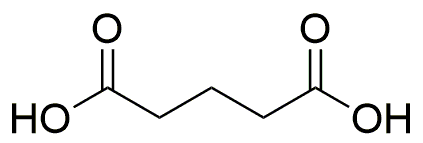Glutaric acid is widely utilized in research focused on various applications across different industries. Here are five practical uses:
- Pharmaceuticals: It serves as an intermediate in the synthesis of various drugs, including those used for treating neurological disorders. Its role in drug formulation enhances bioavailability and efficacy.
- Polymer Production: Glutaric acid is used in the production of biodegradable polymers, which are increasingly important in reducing plastic waste. This application supports sustainability efforts in the packaging industry.
- Food Industry: It acts as a food additive and preservative, helping to maintain freshness and extend shelf life. This is particularly beneficial for manufacturers looking to improve product stability.
- Cosmetics: In cosmetic formulations, it functions as a pH adjuster and stabilizer, ensuring that products maintain their intended properties over time, which is crucial for consumer satisfaction.
- Research and Development: It is frequently used in biochemical research, particularly in studies involving metabolic pathways and enzyme activity, providing insights that can lead to new therapeutic approaches.
General Information
Properties
Safety and Regulations
Applications
Glutaric acid is widely utilized in research focused on various applications across different industries. Here are five practical uses:
- Pharmaceuticals: It serves as an intermediate in the synthesis of various drugs, including those used for treating neurological disorders. Its role in drug formulation enhances bioavailability and efficacy.
- Polymer Production: Glutaric acid is used in the production of biodegradable polymers, which are increasingly important in reducing plastic waste. This application supports sustainability efforts in the packaging industry.
- Food Industry: It acts as a food additive and preservative, helping to maintain freshness and extend shelf life. This is particularly beneficial for manufacturers looking to improve product stability.
- Cosmetics: In cosmetic formulations, it functions as a pH adjuster and stabilizer, ensuring that products maintain their intended properties over time, which is crucial for consumer satisfaction.
- Research and Development: It is frequently used in biochemical research, particularly in studies involving metabolic pathways and enzyme activity, providing insights that can lead to new therapeutic approaches.
Documents
Safety Data Sheets (SDS)
The SDS provides comprehensive safety information on handling, storage, and disposal of the product.
Product Specification (PS)
The PS provides a comprehensive breakdown of the product’s properties, including chemical composition, physical state, purity, and storage requirements. It also details acceptable quality ranges and the product's intended applications.
Certificates of Analysis (COA)
Search for Certificates of Analysis (COA) by entering the products Lot Number. Lot and Batch Numbers can be found on a product’s label following the words ‘Lot’ or ‘Batch’.
*Catalog Number
*Lot Number
Certificates Of Origin (COO)
This COO confirms the country where the product was manufactured, and also details the materials and components used in it and whether it is derived from natural, synthetic, or other specific sources. This certificate may be required for customs, trade, and regulatory compliance.
*Catalog Number
*Lot Number
Safety Data Sheets (SDS)
The SDS provides comprehensive safety information on handling, storage, and disposal of the product.
DownloadProduct Specification (PS)
The PS provides a comprehensive breakdown of the product’s properties, including chemical composition, physical state, purity, and storage requirements. It also details acceptable quality ranges and the product's intended applications.
DownloadCertificates of Analysis (COA)
Search for Certificates of Analysis (COA) by entering the products Lot Number. Lot and Batch Numbers can be found on a product’s label following the words ‘Lot’ or ‘Batch’.
*Catalog Number
*Lot Number
Certificates Of Origin (COO)
This COO confirms the country where the product was manufactured, and also details the materials and components used in it and whether it is derived from natural, synthetic, or other specific sources. This certificate may be required for customs, trade, and regulatory compliance.

